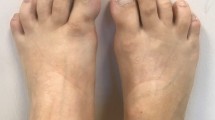Abstract
Fibrodysplasia ossificans progressiva (FOP), a rare autosomal dominant disorder, is characterized by symmetrical congenital skeletal abnormalities and progressive heterotopic ossification of the connective tissues. At present, more than 300 years after the first report by Patin in 1648 in which he described the woman who “turned to wood”, its pathogenesis remains largely unknown and its therapy is limited to symptom-modifying trials. However, significant progress has been recently made and new data on the molecular organization and regulation of normal and disordered bone induction are likely to lead to a more specific therapy. FOP is believed to be a genetic disorder characterized by a disturbed expression of the endochondral osteogenesis programme, and the remarkable “clues from the fly” reported by Kaplan et al. [8] in 1990 suggest a gain-of-function mutation in the genetic regulation of bone morphogenetic proteins.
Similar content being viewed by others
Abbreviations
- BMP :
-
bone morphogenetic protein
- dpp :
-
decapentaplegic
- EHDP :
-
ethane-1-hydroxy-1,1-diphosphonate
- FOP :
-
fibrodysplasia ossificans progressiva
- TGF-β :
-
transforming growth factor-β
References
Bruni L, Giammaria P, Tozzi MC, et al (1990) Fibrodysplasia ossificans progressiva. An 11-year-old boy treated with a diphosphonate. Acta Paediatr Scand 79: 994–998
Cohen RB, Hahn GV, Tabas JA, et al (1993) The natural history of heterotopic ossification in patients who have fibrodysplasia ossificans progressiva. A study of 44 patients. J Bone Joint Surg 75-A:215–219
Connor JM, Evans DAP (1982) Fibrodysplasia ossificans progressiva. The clinical features and natural history of 34 patients. J Bone Joint Surg 64-B:76–83
Hahn GV, Cohen RB, Wozney JM, et al (1992) A bone morphogenetic subfamily: chromosomal localization of human genes for BMP5, BMP6 and BMP7. Genomics 14:759–762
Heemskerk J, DiNardo S (1994) Drosophila hedgehog acts as a morphogen in cellular patterning. Cell 76: 449–460
Kaplan FS, Zasloff MA (1991) The first annual report on the FOP Collaborative Research Project, Division of Metabolic Bone Disease, Hospital of the University of Pennsylvania, Philadelphia, PA, USA
Kaplan FS, Zasloff MA (1992) The second annual report on the FOP Collaborative Research Project, Division of Metabolic Bone Disease, Hospital of the University of Pennsylvania, Philadelphia, PA, USA
Kaplan FS, Tabas JA, Zasloff MA (1990) Fibrodysplasia ossificans progressiva: a clue from the fly? Calcif Tissue Int 47:117–125
Kaplan FS, McCluskey W, Hahn G, et al (1993) Genetic transmission of fibrodysplasia ossificans progressiva. J Bone Joint Surg 75-A:1214–1220
Kaplan FS, Tabas JA, Gannon FH, et al (1993) The histopathology of fibrodysplasia ossificans progressiva. An endochondral process. J Bone Joint Surg 75-A:220–230
Kaplan FS, Craver R, MacEwen GD, et al (1994) Progressive osseous heteroplasia (POH): a distinct developmental disorder of heterotopic ossification. J Bone Joint Surg 76-A:425–436
Kaplan FS, Hahn GV, Zasloff MA (1994) Heterotopic ossification: two rare forms and what they can teach us. A comprehensive review. J Am Ac Orthop Surg 2(5):288–296
Kaplan FS, Shore EM, Zasloff MA (1994) The third annual report of the FOP Collaborative Research Project, Division of Metabolic Bone Disease, Hospital of the University of Pennsylvania, Philadelphia, PA, USA
Padgett RW, Johnston RDS, Gelbart WM (1987) A transcript from a Drosophila pattern gene predicts a protein homologous to the transforming growth factor-β family. Nature 325:81–84
Padgett RW, Wozney JM, Gelbart WM (1993) Human BMP sequences can confer normal dorsal-ventral patterning in the Drosophila embryo. Proc Natl Acad Sci USA 90:2905–2909
Patin G (1648) Lettres choisies de fev M. Guy Patin, ... (Letter of Aug. 27, 1648). Cologne, Pierre du Laurens 1692, vol. I, 28
Rogers JG, Dorst JP, Geho WB (1977) Use and complications of high-dose disodium etidronate therapy in fibrodysplasia ossificans progressiva. J Pediatr 91:1011–1014
Russell RG, Smith R, Bishop MC, Price DA (1972) Treatment of myositis ossificans with a diphosphonate. Lancet 1:10–11
Schroeder HW, Zasloff MA (1980) The hand and foot malformations in fibrodysplasia ossificans progressiva. Johns Hopkins Med J 147:73–78
Shah PB, Zasloff MA, Drummond D, Kaplan FS (1994) Spinal deformity in patients who have fibrodysplasia ossificans progressiva. J Bone Joint Surg 76-A:1442–1450
Subramaniam M, Oursler MJ, Rasmussen K, et al (1995) TGF-β regulation of nuclear proto-oncogenes and TGF-β gene expression in normal human osteoblast-like cells. J Cell Biochem 57:52–61
Tabas JA, Hahn GV, Cohen RB, et al (1993) Chromosomal assignment of the human gene for Bone Morphogenetic Protein4. Clin Orthop 293:310–316
Tabas JA, Kaplan FS, Dalinko MK, et al (1992) A family with multifocal heterotopic ossification: genetic transmission of fibrodysplasia ossificans progressiva. Calcif Tissue Int 50:387
Tabas JA, Zasloff MA, Wasmuth JJ, et al (1991) Bone Morphogenetic Protein: chromosomal localization of human genes for BMP1, BMP2A and BMP3. Genomics 9:283–285
Urist MR (1965) Bone: formation by autoinduction. Science 150:893–899
Urist MR, DeLange RJ, Finerman GAM (1983) Bone cell differentiation and growth factors. Science 220:680–686
Verberne AA, Bos CF, Kuethe MC (1984) Fibrodysplasia ossificans progressiva bij een tweejarig meisje. Tijdschr Kindergeneeskd 56(4):167–169
Wozney JM, Rosen V, Celeste AJ, et al (1988) Novel regulators of bone formation: molecular clones and activities. Science 242:1528–1534
Wrana JL, Attisano L, Wieser R, et al (1994) Mechanism of activation of the TGF-β receptor. Nature 370:341–347
Author information
Authors and Affiliations
Rights and permissions
About this article
Cite this article
Buyse, G., Silberstein, J., Goemans, N. et al. Fibrodysplasia ossificans progressiva: Still turning into wood after 300 years?. Eur J Pediatr 154, 694–699 (1995). https://doi.org/10.1007/BF02276711
Received:
Accepted:
Issue Date:
DOI: https://doi.org/10.1007/BF02276711




